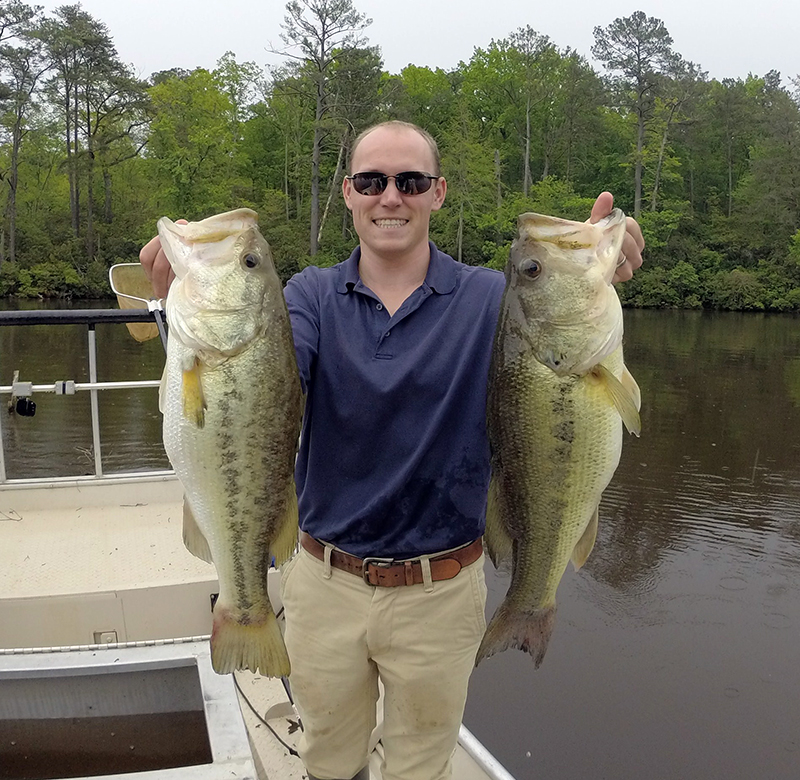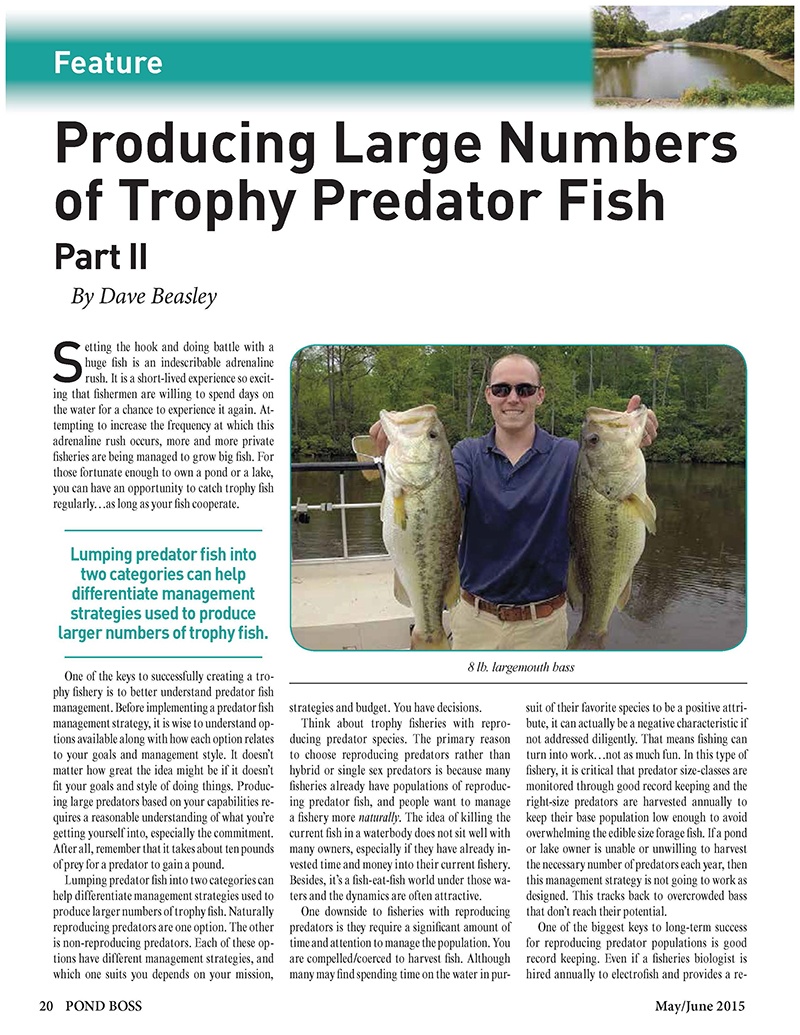Producing Large Numbers of Trophy Predator Fish Part II
May 29th, 2015
AS SEEN IN Pond Boss Magazine, May/June 2015: Written by Industry Expert, David Beasley, Fisheries Biologist, SOLitude Lake Management
 Setting the hook and doing battle with a huge fish is an indescribable adrenaline rush. It is a short-lived experience so exciting that fishermen are willing to spend days on the water for a chance to experience it again. Attempting to increase the frequency at which this adrenaline rush occurs, more and more private fisheries are being managed to grow big fish. For those fortunate enough to own a pond or a lake, you can have an opportunity to catch trophy fish regularly…as long as your fish cooperate.
Setting the hook and doing battle with a huge fish is an indescribable adrenaline rush. It is a short-lived experience so exciting that fishermen are willing to spend days on the water for a chance to experience it again. Attempting to increase the frequency at which this adrenaline rush occurs, more and more private fisheries are being managed to grow big fish. For those fortunate enough to own a pond or a lake, you can have an opportunity to catch trophy fish regularly…as long as your fish cooperate.
One of the keys to successfully creating a trophy fishery is to better understand predator fish management. Before implementing a predator fish management strategy, it is wise to understand options available along with how each option relates to your goals and management style. It doesn’t matter how great the idea might be if it doesn’t fit your goals and style of doing things. Producing large predators based on your capabilities requires a reasonable understanding of what you’re getting yourself into, especially the commitment. After all, remember that it takes about ten pounds of prey for a predator to gain a pound.
Lumping predator fish into two categories can help differentiate management strategies used to produce larger numbers of trophy fish. Naturally reproducing predators are one option. The other is non-reproducing predators. Each of these options have different management strategies, and which one suits you depends on your mission, strategies and budget. You have decisions.
Think about trophy fisheries with reproducing predator species. The primary reason to choose reproducing predators rather than hybrid or single sex predators is because many fisheries already have populations of reproducing predator fish, and people want to manage a fishery more naturally. The idea of killing the current fish in a waterbody does not sit well with many owners, especially if they have already invested time and money into their current fishery. Besides, it’s a fish-eat-fish world under those waters and the dynamics are often attractive.
Why should you have a predator to prey management plan?
One downside to fisheries with reproducing predators is they require a significant amount of time and attention to manage the population. You are compelled/coerced to harvest fish. Although many may find spending time on the water in pursuit of their favorite species to be a positive attribute, it can actually be a negative characteristic if not addressed diligently. That means fishing can turn into work…not as much fun. In this type of fishery, it is critical that predator size-classes are monitored through good record keeping and the right-size predators are harvested annually to keep their base population low enough to avoid overwhelming the edible size forage fish. If a pond or lake owner is unable or unwilling to harvest the necessary number of predators each year, then this management strategy is not going to work as designed. This tracks back to overcrowded bass that don’t reach their potential.
One of the biggest keys to long-term success for reproducing predator populations is good record keeping. Even if a fisheries biologist is hired annually to electrofish and provides a revised management strategy, it is still important to record the length of each predator you catch. Lengths and weights are even more helpful. Having creel records as a stand-alone data set or in conjunction with an annual electrofishing study will provide a valuable advantage when assessing the fishery and adjusting harvest strategies. With proper record keeping you will be able to compare your catch rates from year to year, figure out if you are harvesting enough predators, and then adjust your harvest strategies based on the fishery’s progress.
 Waterbodies with reproducing predator fish have the ability to be great fisheries, but the risk of under-harvesting teamed with the risk of inefficient conversion rates due to predators eating young predators reduces the potential quantity of trophy fish. Conversely, proper and diligent harvest increases your odds of more large fish.
Waterbodies with reproducing predator fish have the ability to be great fisheries, but the risk of under-harvesting teamed with the risk of inefficient conversion rates due to predators eating young predators reduces the potential quantity of trophy fish. Conversely, proper and diligent harvest increases your odds of more large fish.
Understanding the natural limitations of a lake and its fishery establishes criteria to design, create and support fisheries with artificially inflated numbers of large predator fish. A less natural management option, but often the one with a greater reward, is to create a trophy fishery with predators that do not reproduce. This is done by stocking single sex populations or by stocking hybrid species.
To successfully establish a fishery with a non-reproducing predator population requires starting with a clean slate and clean watershed. For existing fisheries, this requires resetting the fishery. Resetting is the process of removing all fish from the system. The concept of non-reproducing predator populations and resetting fisheries go hand and hand since it is difficult to establish a non-reproducing population otherwise. This reset is completed by either draining a waterbody 100 percent, applying rotenone (fish toxin) to eradicate the fish, or a combination of the two.
One big advantage of non-reproducing predators is that they require minimal harvesting. This simplified process results in better chances of maximizing the number of large predators that the fishery can support, simply because zero space in the food chain is dedicated to growing small predators into the fishery. This type of fishery with limited predators provides a high probability that the forage base will thrive alongside the predator population, allowing predators to feed aggressively and pack on the pounds. The key to achieving aggressive growth rates is to stock the predator population in low enough numbers to avoid overwhelming the forage base, unless you have a plan to support a larger forage base.
Non-reproducing populations of predators help reduce the number of tiers within the food chain, while also limiting the number of predators within the fishery. Waterbodies can only produce a limited amount of forage, without substantial outside help, and the amount of weight that each predator can grow annually is relative to the number of predators competing for available forage.
Although this type of fishery can support a larger number of trophy fish, it actually provides lower catch rates overall since there is no annual recruitment. Due to the lack of annual recruitment, this type of fishery requires stocking predator fish on an ongoing basis. It is typical to restock with a low number of predators every 1-3 years.
As with most things that are manipulated and unnatural, managing non-reproducing predators can be more expensive than one may desire, but the opportunity to create a better fishing experience can be worth the increased cost to some people. Even though fisheries with non-reproducing predators have great upsides, many people struggle with the idea of starting over since they are either committed to their current fishery, or because they simply are not willing to kill their current fish population. It is not uncommon for people to compromise on goals to avoid killing off their current fish, or because they have limited available funding for fisheries management. Many people choose to manage their current fishery for decent fishing and forego the effort and expense related to producing high catch rates of trophy fish.
Quite a few professional fisheries managers around the nation are managing female-only largemouth bass lakes. It takes a special site to have zero risk of introducing male bass and lots of due diligence to make sure a male never enters the system. That means we better know those fish we stock are absolutely females. The forage fish population is managed for these larger bass as they grow. Big fish need big meals, so diversity of the food chain is an important part of the management strategy. In a natural lake, the food chain is more of a pyramid, starting with energy from the sun, moving upward through insects, small fish and so on. In single sex populations, attention to the food chain is important.
But, wait, there may be hope for another option. Several fisheries managers around the nation are stocking large female bass into existing reproducing fisheries in an attempt to alter the ratios of males to females. Since female largemouth bass grow larger, adding known females, especially if they are tagged, can jump start the numbers of large bass your reproducing fishery can have. Part of the selective culling process includes removing males and being selective about which females are left behind. An important caveat here is that you need to be able to tell the difference between males and females.
 For hybrids, you need to know a few basic facts. Hybrid stripers, tiger muskies and tiger trout are the primary pond species that do not produce viable eggs. Hybrid sunfish reproduce, so do hybrid crappie. Some crosses of channel catfish and blue catfish can successfully reproduce as well. F1 crosses of largemouth bass are not hybrids at all, they are intergrade crosses of the same species. They can’t be a hybrid. So, beware.
For hybrids, you need to know a few basic facts. Hybrid stripers, tiger muskies and tiger trout are the primary pond species that do not produce viable eggs. Hybrid sunfish reproduce, so do hybrid crappie. Some crosses of channel catfish and blue catfish can successfully reproduce as well. F1 crosses of largemouth bass are not hybrids at all, they are intergrade crosses of the same species. They can’t be a hybrid. So, beware.
If a fishery is productive, and the forage base is in good shape, replenishing itself without being overeaten, it can make sense to stick with the current reproducing predators rather than resetting, but in reality few fisheries have a good enough forage base to serve as the foundation of a trophy fishery which yields big numbers of huge fish, even if you make the commitment to continue culling small fish on a regular basis. As a result, the time, effort and money it takes to grow large numbers of trophy size fish in a waterbody that was not reset takes longer and can be more expensive than if one resets the fishery and starts over. Regardless of whether you are stocking predators that reproduce or not, this process of resetting the fishery provides far more control over the success of both the forage base and predator fish and as a result, reset fisheries provide the highest probability of establishing an efficient trophy fishery. That’s why we hear about young lakes producing so many big fish.
Many variables go into the decision of what type of fishery to establish. Although populations of non-reproducing predators provide better odds of establishing the largest number of trophy size predators that a waterbody can support, they are not always the best option. Trophy fisheries are exciting and there is a place for fisheries with both reproducing populations of predators as well as non-reproducing populations. The important part is not whether or not your predators reproduce, but is that you implement the best strategies possible based on the type of fishery you have chosen.
Here’s the bottom line. Your strategy not only includes which option you choose for growing predator fish, you also need to define a strategy for the food chain which will adequately support your chosen direction. Effort to manage the food chain will be just as important as your decisions about those predator fish you plan to grow to giants sizes.
Contact the experts at 888-480-5253 for all of your lake, pond and fisheries management needs.
David Beasley is a Fisheries Biologist with SOLitude Lake Management. Since 1998, SOLitude Lake Management has been committed to providing full service lake and pond management services that improve water quality, preserve natural resources, and reduce our environmental footprint. Services are available throughout the Eastern United States. Fisheries management consulting and aquatic products are available nationwide. Learn more about SOLitude Lake Management and purchase products at www.solitudelakemanagement.com.










